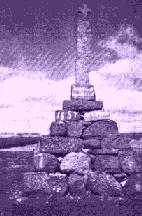|
|
|
|
|

The old stone cross rises up, almost twenty feet high. It stands beside the road, the land behind it slipping sharply down to rolling fields. Looking at it from a distance, a visitor or stranger used to Scotland might guess that it is some sort of battle memorial. Seen close up, the monument quickly tells its story. Roughlypainted on the stones are the chilling words: "Maggie Wall burnt here 1657 as a Witch." In the name of . . . well, in the name of what? A woman was burned at the stake here. If she were lucky she was strangled first. If not, then she died in agony on a pyre of peat and coal doused with tar, perhaps still crying her innocence as the flames around her roared and spat. Who was Maggie Wall? And when over 4,000 women were executed in Scotland for witchcraft in the sixteenth and seventeenth centuries, why commemorate her alone? It is not because, as the Perthshire tourist map says, she was the last to be burned at the stake. She was not. There were many more. Was she old, was she young? Was she an outsider, perhaps? Her name does not appear in the records at all, which is odd. Witch trials were often carefully recorded. Diligent clerks even put down grim details such as the cost of the peat used for the fire and the rope needed by the executioner. But there is nothing mentioned about poor Maggie. A hundred years ago, Dunning's minister actually claimed that the story was a hoax! But if it was a hoax, why build a monument using such huge boulders and square cut stones? A wreath is left at the cairn each year, with a card saying: "In memory of Maggie Wall, Burnt by the Church in the Name of Christianity." Nobody knows what her "crime" was. Perhaps somebody's cow took sick and died and Maggie got the blame. Maybe she just knew too much for her own good about the special properties of herbs and flowers. There again, perhaps the "Witch Pricker" was called in to look for the "Devil's Mark" on her body, and found it. This was a patch of skin stained red, brown or blue where his three-inch blade gave no pain when he pushed it in. The truth is blacker. Probably it has more to do with politics than spells, for Maggie Wall lived and died in troubled times. She also had the bad luck to live in an area with a terrible reputation for persecuting witches. Six more were executed in Dunning in 1663, in a wood on the other side of the village. That number is terrifying for a village of perhaps a few hundred souls. Fear and hysteria were in the air and no woman was safe. Did someone plot and brood, was a neighbor's chance remark or spiteful accusation the spark needed to light the final ghastly inferno? It is very tempting to think so. There is no other memorial like it in Scotland to a witch. Only a very powerful person could have risked building it, while putting a Christian symbol on top of it was like defying the Church. Ordinary folk would not usually dare to show sympathy to a witch, dead or alive. Who knew where the accusing finger would point next? Whatever the truth of this, here stands Maggie Wall's memorial to this day. But it does not give up its secrets easily. It has another. Who paints the inscription on the stones? The tradition seems to go back a long way. A photograph taken perhaps a hundred years ago shows the lettering already there, just as it is now. But why? Is the task handed down in some local family? Is it done by the same person who lays the wreath? And above all, why does a poor woman who died so long ago matter so much to someone today? Because matter she surely does, and to many people. People visit the site for all sorts of reasons. Scotland's dark and bloody history fascinates some. Perhaps others come to pity, bringing flowers bought from a shop, or taken from the hedgerows. Some try to understand the superstitions of the past. Many simply wonder at human cruelty. But whatever they think about what happened here, the witch's grave keeps its mysteries. |
![]()